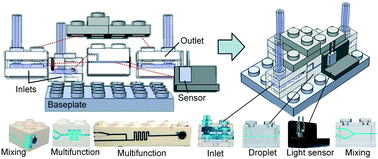High-precision modular microfluidics by micromilling of interlocking injection-molded blocks†
Abstract
Wider use and adaptation of microfluidics is hindered by the infrastructure, knowledge, and time required to build prototype systems, especially when multiple fluid operations and measurements are required. As a result, 3D printing of microfluidics is attracting interest, yet cannot readily achieve the feature size, smoothness, and optical transparency needed for many standard microfluidic systems. Herein we present a new approach to the design and construction of high-precision modular microfluidics, using standard injection-molded blocks that are modified using micromilling and assembled via elastically averaged contacts. Desktop micromilling achieves channel dimensions as small as 50 μm depth and 150 μm width and adhesive films seal channels to allow internal fluid pressure of >400 kPa. Elastically averaged connections between bricks result in a mechanical locating repeatability of ∼1 μm, enabling fluid to pass between bricks via an O-ring seal with >99.9% reliability. We demonstrated and tested block-based systems for generating droplets at rates above 9000 min−1 and COV <3%, and integrated optical sensors. We also show how blocks can be used to build easily reconfigurable interfaces with glass microfluidic devices and imaging hardware. Microfluidic bricks fabricated by FDM and SLA 3D printing cannot achieve the dimensional quality of molded bricks, yet 3D printing allows customized bricks to be integrated with standard LEGOs. Our approach enables a wide variety of modular microfluidic units to be built using a widely available, cost-effective platform, encouraging use in both research and education.



 Please wait while we load your content...
Please wait while we load your content...